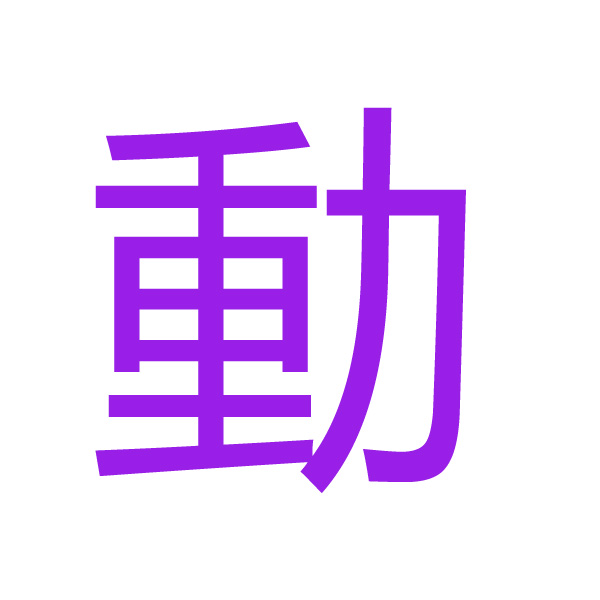
1. Meaning and Usage
The core meaning of the kanji 動 is "to move," "to operate," or "to change." It is used for all kinds of movement, from physical motion to the functioning of machines and changes in abstract concepts.
Common Readings and Words:
どう (dō): The Sino-Japanese reading used in compound words.
自動車 (jidōsha): Automobile, car. (自-self + 動-move + 車-vehicle → "self-moving vehicle")
運動 (undō): Exercise, motion. (運-carry + 動-move)
活動 (katsudō): Activity, action. (活-lively + 動-move)
動画 (dōga): Video. (動-move + 画-picture)
うご (ugo): The native Japanese reading used in verbs.
動く (ugoku): The basic verb "to move."
動かす (ugokasu): To move (something), to set in motion.
2. Correct Stroke Order
Writing 動 correctly requires attention to its two main components. The correct stroke order ensures balance and stability, much like the motion it represents.
Total Strokes: 11
Step-by-Step Breakdown:
Left Component: 重 (Omoi - Heavy)
Stroke 1: Short left-falling stroke (撇).
Stroke 2: Horizontal stroke (横) below it.
Stroke 3: Vertical stroke (竖) in the center.
Stroke 4: Short horizontal stroke inside.
Stroke 5: Short vertical stroke inside.
Stroke 6: Long horizontal stroke at the bottom.
Stroke 7: Short horizontal stroke at the very bottom (this is part of the radical).
Right Radical: 力 (Chikara - Power)
Stroke 8: The horizontal折 (oritsu) stroke that forms the top and side of the radical.
Stroke 9: The left-falling stroke (撇) that completes the radical.
Key Stroke Order Rules Applied:
Left to Right: The entire left component (重) is written before the right radical (力).
Top to Bottom: This rule is strictly followed within the 重 component.
Horizontal before Vertical: Visible in the construction of 重.
3. Historical Origins and Etymology (The "Story" Behind the Kanji)
The history of 動 is a perfect example of an ideographic compound (会意文字 kaii moji), where the meaning is logically derived from its parts.
The kanji 動 is composed of two distinct components:
重 (Omoi): This character means "heavy." Its original pictograph showed a person standing with a heavy load on their back.
力 (Chikara): This character means "power," "strength," or "effort." Its pictograph is thought to be a strong, muscular arm.
The Combined Meaning:
The meaning of 動 is created by the powerful interaction of these two components. It visually and conceptually represents the idea of:
"Using strength (力) to move something heavy (重)."
This is an incredibly intuitive and vivid origin. True "movement" or "motion," in its most fundamental sense, isn't just any movement—it's the act of overcoming inertia. The most definitive example of this is using physical power to set a heavy object in motion.
From this core concept of applying force to create movement, the meaning expanded to include all forms of motion:
Physical movement of objects (動く ugoku)
The operation of machines (自動 jidō - automatic)
Changes in situation (動向 dōkō - trend)
Emotional movement (感動 kandō - to be deeply moved/emotionally stirred)
4. Example Sentences
Here are some example sentences showing the different uses of 動.
As a Verb "To Move" (うごく):
Romaji: Sono neko wa zenzen ugokanai.
English: That cat isn't moving at all.
その猫は全然動かない。
As a Causative Verb "To Move Something" (うごかす):
Romaji: Kono rebā o ugokashite kudasai.
English: Please move this lever.
このレバーを動かしてください。
In a Compound Word (どう):
Romaji: Mainichi undō suru no wa kenkō ni ii.
English: Exercising every day is good for your health.
毎日運動するのは健康にいい。
Summary
Meaning: To move, to operate, to function, to change.
Writing: 11 strokes. Write the left component 重 (heavy) first, then the right radical 力 (power).
Origin: An ideographic compound that vividly depicts the concept of "using strength/power (力) to move a heavy object (重)." This powerful image of overcoming inertia forms the basis for all its modern meanings related to motion and change.